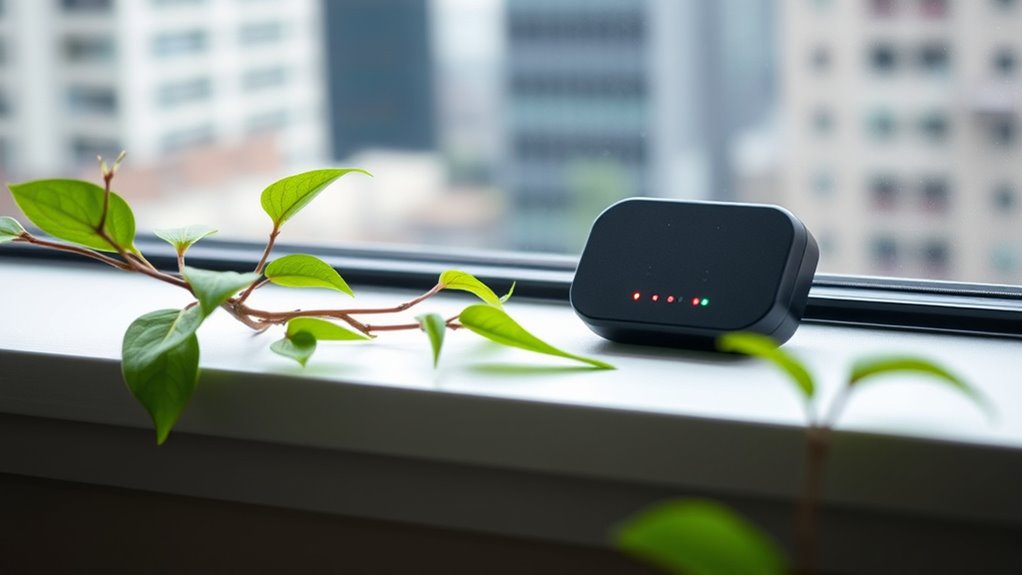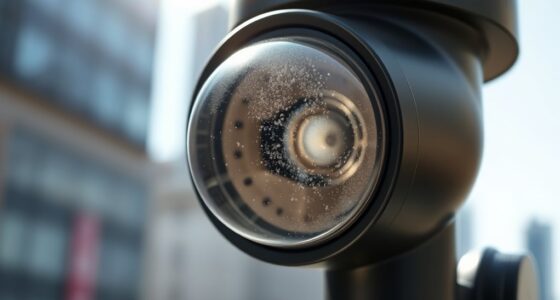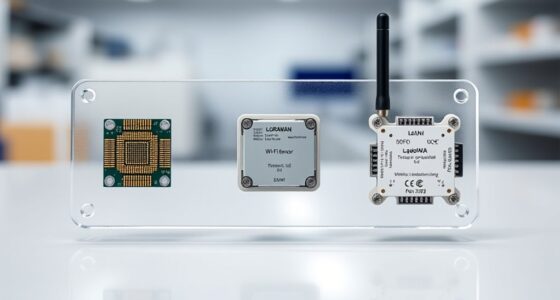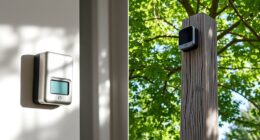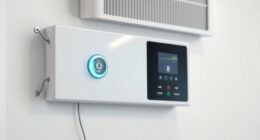To guarantee continuous air quality monitoring with minimal maintenance, focus on low-power design strategies. Use sensors and components that consume little energy, and incorporate sleep modes to conserve power during inactivity. Combine this with energy harvesting techniques like solar or vibration energy collection to extend device lifespan. Efficient firmware management and adaptive power management are also key. If you keep exploring, you’ll discover more ways to optimize your system for long-term, sustainable operation.
Key Takeaways
- Implement sleep modes to minimize power during periods of low activity or measurement intervals.
- Incorporate energy harvesting (solar, vibration, thermal) to supplement battery power and extend device runtime.
- Use low-power sensors and components optimized for minimal energy consumption.
- Design efficient firmware for intelligent power management and dynamic switching between active and sleep states.
- Account for environmental variability by adapting energy harvesting and power strategies for reliable, continuous monitoring.
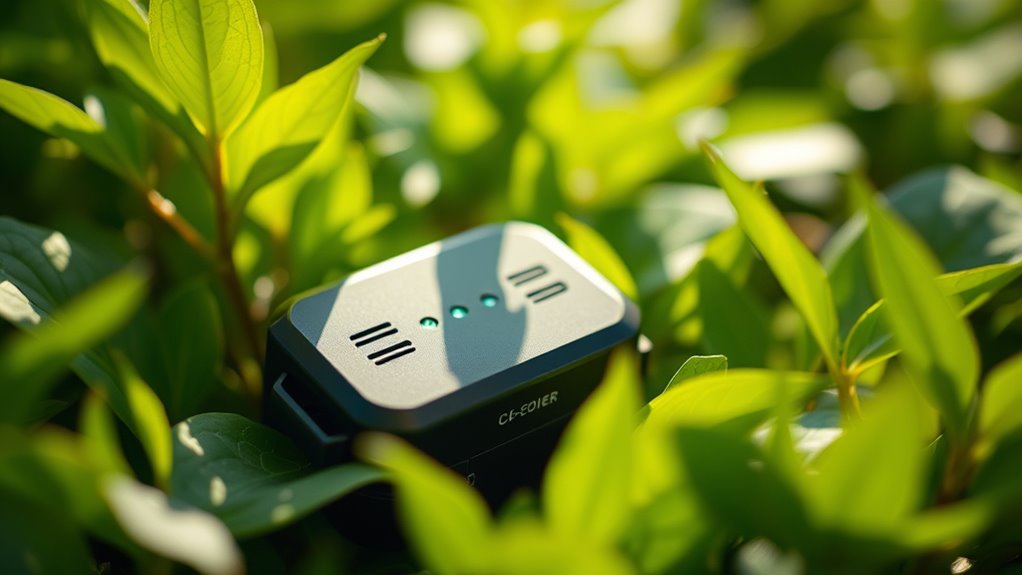
Have you ever wondered how electronic devices last longer on a single charge? It’s a question that often comes up when you’re dealing with remote sensors or portable gadgets, especially in applications like continuous air quality monitoring. Low-power design plays an essential role in making sure these devices keep running without frequent battery replacements or recharges. One effective strategy involves integrating energy harvesting techniques, which allow your device to gather energy from the environment—like solar, vibration, or thermal sources—and supplement its power supply. This approach not only extends operational time but also reduces dependence on traditional batteries, contributing to a more sustainable system. This way, the device can operate longer between charges or even indefinitely in some cases. Coupled with energy harvesting, smart use of sleep modes becomes vital. Sleep modes are low-power states your device can enter when it’s not actively measuring or transmitting data. By minimizing power consumption during these idle periods, you extend battery life markedly. For instance, during periods of low air pollution, your sensor can switch to sleep mode, waking only at scheduled intervals to take readings. This approach conserves energy and guarantees continuous operation over extended periods.
Implementing energy harvesting and sleep modes together creates a synergy that optimizes power efficiency. When your device can harvest ambient energy, it reduces its reliance on batteries, allowing for longer deployments without maintenance. Meanwhile, sleep modes cut down power usage during inactive times, which is vital in remote or hard-to-access locations. The key is designing your system to intelligently switch between active and sleep states based on environmental conditions or measurement needs. For example, if air quality levels are stable, your sensor can stay in sleep mode longer, waking up only when potential changes are detected. This not only saves energy but also reduces data processing and transmission loads, further conserving power.
Incorporating energy harvesting and sleep modes requires careful planning during the design phase. You need to select sensors and components with low power consumption and ensure your firmware can manage power states efficiently. It’s also important to consider the variability of environmental energy sources; solar panels work well during the day but may be less effective at night, so your system should be capable of adapting. Additionally, referring to best practices in low-power design can help optimize your system’s energy efficiency. Ultimately, the goal is to create a low-power device that reliably monitors air quality over long durations without frequent battery replacements. By leveraging energy harvesting techniques and optimizing sleep modes, you’ll design a system that’s not only energy-efficient but also sustainable and resilient in various operating conditions.
Frequently Asked Questions
What Are the Latest Advancements in Low-Power Sensor Technology?
You’ll find that recent advancements in low-power sensor technology focus on improving power management and sensor calibration. New sensors now optimize energy use through smarter sleep modes and adaptive sampling, extending battery life. Calibration techniques have also become more efficient, ensuring accuracy over time without draining power. These innovations enable continuous monitoring with minimal energy, making your air quality devices more reliable, portable, and sustainable for long-term use.
How Does Ambient Temperature Affect Sensor Power Consumption?
A penny saved is a penny earned, and temperature impacts your sensor’s power use. When ambient temperature rises, thermal effects can cause sensor calibration issues, leading to increased power consumption as the sensor struggles to maintain accuracy. Conversely, colder temperatures might require more energy to keep the sensor warm enough to operate correctly. Managing thermal effects through design helps optimize power and guarantees reliable readings across temperature variations.
Can Energy Harvesting Extend Device Operational Life?
Yes, energy harvesting can extend your device’s operational life by providing supplementary power, reducing reliance on battery replacements. It captures ambient energy from sources like solar or vibration, supporting wireless transmission and sensor operation. This means your air quality monitor can run longer without frequent maintenance, ensuring continuous data collection. By integrating energy harvesting, you optimize energy efficiency and minimize downtime caused by battery depletion or replacement.
What Are Cost-Effective Low-Power Design Strategies?
Did you know that optimizing power consumption can reduce device energy use by over 50%? To achieve this, you should implement cost-effective low-power design strategies like energy-efficient protocols and low-power communication techniques. These approaches minimize energy waste, extend device lifespan, and maintain reliable data transmission. By focusing on efficient hardware and software, you guarantee your air quality sensors run longer without added costs, making your monitoring system smarter and more sustainable.
How to Ensure Data Accuracy With Minimal Power Use?
You can guarantee data accuracy with minimal power use by regularly calibrating your sensors to maintain precision. Incorporate data redundancy, such as multiple sensors measuring the same parameter, to cross-verify readings and detect anomalies. Use low-power communication protocols to transmit critical data efficiently. Combining these strategies helps you balance energy conservation with reliable air quality monitoring, ensuring your system provides accurate, consistent data without draining power resources.
Conclusion
By embracing low-power design, you open the future of continuous air quality monitoring—an invisible guardian watching over us. Just as a lighthouse guides ships safely home, your innovations can illuminate a healthier world without draining resources. Remember, every small efficiency sparks a larger change, guiding us toward sustainable solutions. So, harness the power of low-power technology and let your work be the steady heartbeat of cleaner, safer air for all.
